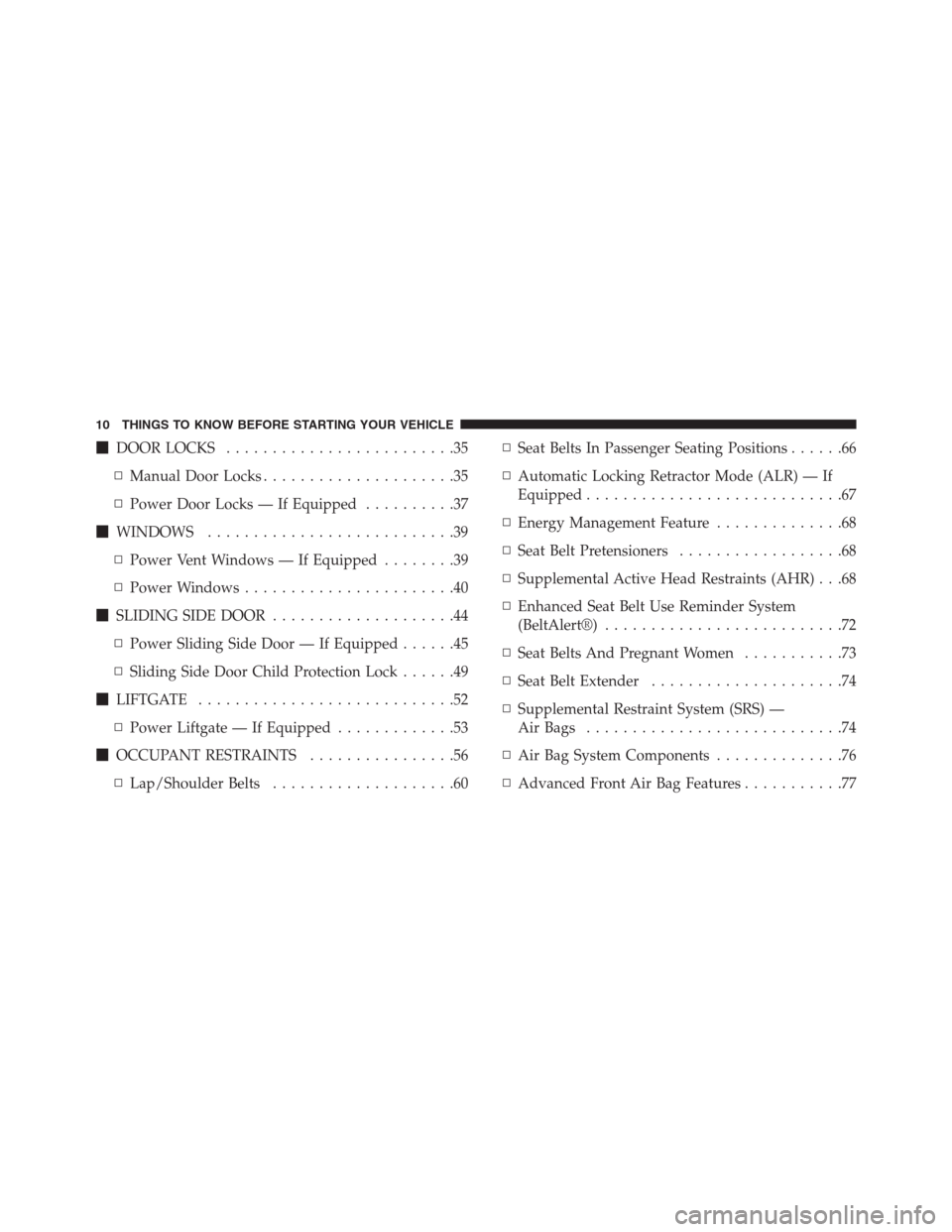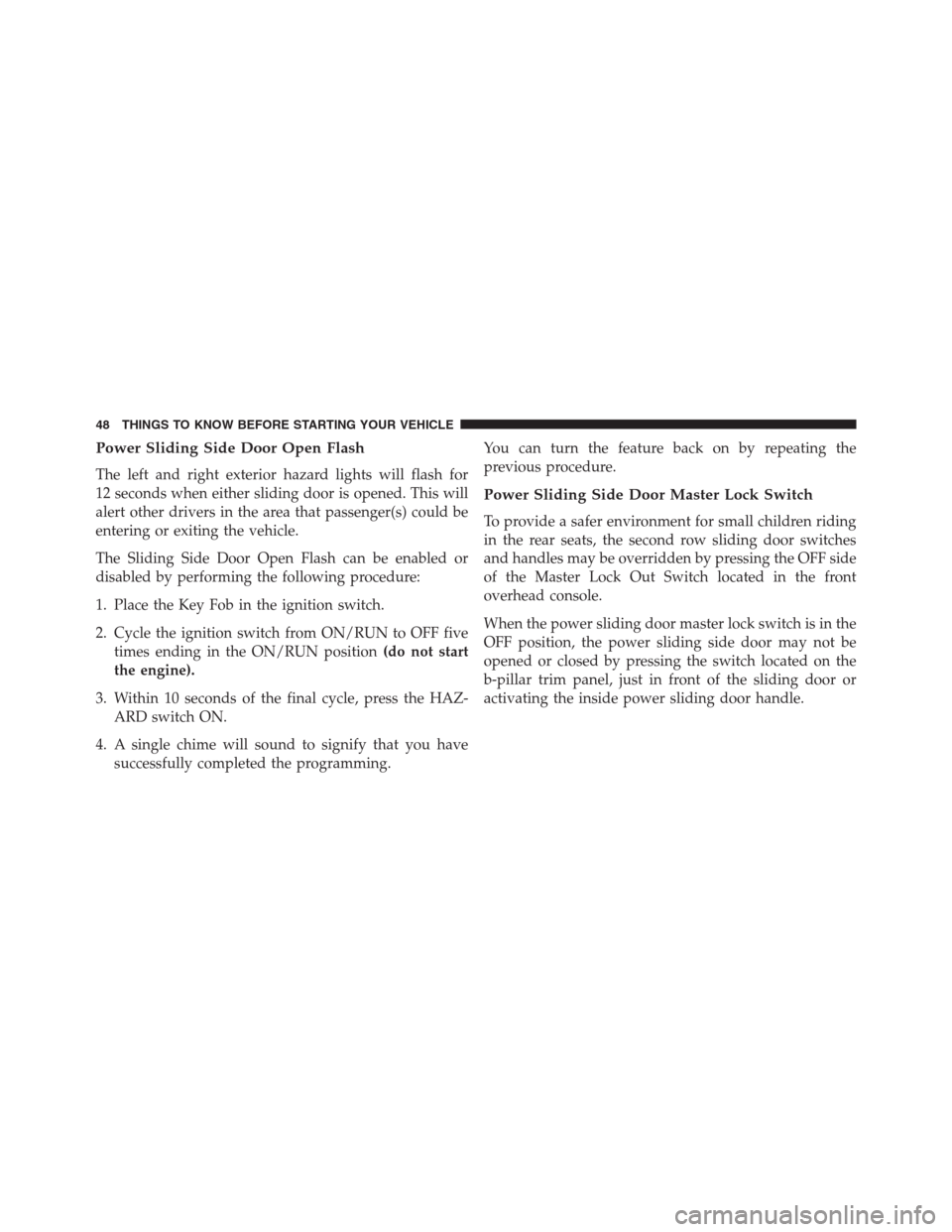Page 12 of 683

�DOOR LOCKS.........................35
▫Manual Door Locks.....................35
▫Power Door Locks — If Equipped..........37
�WINDOWS...........................39
▫Power Vent Windows — If Equipped........39
▫Power Windows.......................40
�SLIDING SIDE DOOR....................44
▫Power Sliding Side Door — If Equipped......45
▫Sliding Side Door Child Protection Lock......49
�LIFTGATE............................52
▫Power Liftgate — If Equipped.............53
�OCCUPANT RESTRAINTS................56
▫Lap/Shoulder Belts....................60▫Seat Belts In Passenger Seating Positions......66
▫Automatic Locking Retractor Mode (ALR) — If
Equipped............................67
▫Energy Management Feature..............68
▫Seat Belt Pretensioners..................68
▫Supplemental Active Head Restraints (AHR) . . .68
▫Enhanced Seat Belt Use Reminder System
(BeltAlert®)..........................72
▫Seat Belts And Pregnant Women...........73
▫Seat Belt Extender.....................74
▫Supplemental Restraint System (SRS) —
Air Bags............................74
▫Air Bag System Components..............76
▫Advanced Front Air Bag Features...........77
10 THINGS TO KNOW BEFORE STARTING YOUR VEHICLE
Page 13 of 683
▫Air Bag Deployment Sensors And Controls....81
▫Event Data Recorder (EDR)...............88
▫Child Restraints.......................89
�COMMERCIAL CARGO VEHICLES (NO FACTORY
INSTALLED REAR SEATS) — IF EQUIPPED . . .113
▫Restraining Infants And Small Children In
Commercial Cargo Vehicles...............114
�ENGINE BREAK-IN RECOMMENDATIONS . . .116�SAFETY TIPS.........................117
▫Transporting Passengers.................117
▫Exhaust Gas.........................117
▫Safety Checks You Should Make Inside The
Vehicle.............................118
▫Periodic Safety Checks You Should Make Outside
The Vehicle.........................120
2
THINGS TO KNOW BEFORE STARTING YOUR VEHICLE 11
Page 50 of 683

Power Sliding Side Door Open Flash
The left and right exterior hazard lights will flash for
12 seconds when either sliding door is opened. This will
alert other drivers in the area that passenger(s) could be
entering or exiting the vehicle.
The Sliding Side Door Open Flash can be enabled or
disabled by performing the following procedure:
1. Place the Key Fob in the ignition switch.
2. Cycle the ignition switch from ON/RUN to OFF five
times ending in the ON/RUN position(do not start
the engine).
3. Within 10 seconds of the final cycle, press the HAZ-
ARD switch ON.
4. A single chime will sound to signify that you have
successfully completed the programming.You can turn the feature back on by repeating the
previous procedure.
Power Sliding Side Door Master Lock Switch
To provide a safer environment for small children riding
in the rear seats, the second row sliding door switches
and handles may be overridden by pressing the OFF side
of the Master Lock Out Switch located in the front
overhead console.
When the power sliding door master lock switch is in the
OFF position, the power sliding side door may not be
opened or closed by pressing the switch located on the
b-pillar trim panel, just in front of the sliding door or
activating the inside power sliding door handle.
48 THINGS TO KNOW BEFORE STARTING YOUR VEHICLE
Page 51 of 683
Sliding Side Door Child Protection Lock
To provide a safer environment for small children riding
in the rear seats, the sliding doors are equipped with a
Child Protection Door Lock system.
NOTE:When the Child Protection Door Lock system is
engaged, the door can be opened only by using the
outside door handle even though the inside door lock is
in the unlocked position.
Overhead Console Power Sliding Door Master Switch
1 — Left Sliding Door 3 — Right Sliding Door
2 — Liftgate 4 — Master Lock
2
THINGS TO KNOW BEFORE STARTING YOUR VEHICLE 49
Page 52 of 683

To Engage the Child Protection Door Lock
1. Open the sliding side door.
2.
Slide the Child Protection Door Lock control inward
(toward the vehicle) to engage the Child Protection Door
Lock.
3. Repeat Steps 1 and 2 on the opposite sliding door.NOTE:
•After engaging the Child Protection Door Lock, always
test the door from the inside to make certain it is in the
desired position.
•When the Child Protection Door Lock system is en-
gaged, (even if the inside door lock is in the unlocked
position) the door can be opened only by using the
outside door handle, the RKE transmitter, the switches
on the overhead console or the switches located on the
trim panel just in front of the power sliding door.
•
The power sliding side door will operate from the
switches located on the b-pillar trim panel, just in front
of the power sliding door, regardless of the Child
Protection Door Lock lever position.To avoid uninten-
tional operation of the power sliding door from the
rear seats, press the “OFF” Master Lock Out Switch
located in the front overhead console, next to the
driver.
Child Protection Door Lock
50 THINGS TO KNOW BEFORE STARTING YOUR VEHICLE
Page 58 of 683

OCCUPANT RESTRAINTS
Some of the most important safety features in your
vehicle are the restraint systems:
•Three-point lap and shoulder belts for all seating
positions
•Advanced Front Air Bags for driver and front
passenger
•Supplemental Active Head Restraints (AHR) located
on top of the front seats (integrated into the head
restraint) — if equipped
•Supplemental Driver Side Knee Air Bag
•Supplemental Side Air Bag Inflatable Curtains (SABIC)
that span the front, second, and third row seating for
the driver and passengers seated next to a window
•Supplemental Seat-Mounted Side Air Bags (SAB)•An energy-absorbing steering column and steering
wheel
•Knee bolster for front passenger seat occupant
•Front seat belts incorporate pretensioners that may
enhance occupant protection by managing occupant
energy during an impact event
•All seat belt systems (except the driver ’s and third row
center) include Automatic Locking Retractors (ALRs),
which lock the seat belt webbing into position by
extending the belt all the way out and then adjusting
the belt to the desired length to restrain a child seat or
secure a large item in a seat
Please pay close attention to the information in this
section. It tells you how to use your restraint system
properly, to keep you and your passengers as safe as
possible.
56 THINGS TO KNOW BEFORE STARTING YOUR VEHICLE
Page 59 of 683

If you will be carrying children too small for adult-sized
seat belts, the seat belts or the Lower Anchors and Tether
for CHildren (LATCH) feature also can be used to hold
infant and child restraint systems. For more information
on LATCH, refer to Lower Anchors and Tether for
CHildren (LATCH).
NOTE:The Advanced Front Air Bags have a multistage
inflator design. This allows the air bag to have different
rates of inflation based on several factors, including the
severity and type of collision.
Here are some simple steps you can take to minimize the
risk of harm from a deploying air bag:
1.Children 12 years old and under should always ride
buckled up in a rear seat.WARNING!
Infants in rear facing child restraints should never ride
in the front seat of a vehicle with a passenger Ad-
vanced Front Air Bag. An air bag deployment can cause
severe injury or death to infants in that position.
Children that are not big enough to wear the vehicle seat
belt properly (see section on Child Restraints) should be
secured in the rear seat in child restraints or belt-
positioning booster seats. Older children who do not use
child restraints or belt-positioning booster seats should
ride properly buckled up in the rear seat. Never allow
children to slide the shoulder belt behind them or under
their arm.
2
THINGS TO KNOW BEFORE STARTING YOUR VEHICLE 57
Page 60 of 683

If a child from 1 to 12 years old (not in a rear facing child
seat) must ride in the front passenger seat, move the seat
as far back as possible and use the proper child restraint.
(Refer to “Child Restraints”)
You should read the instructions provided with your
child restraint to make sure that you are using it properly.
2.All occupants should always wear their lap and
shoulder belts properly.
3.The driver and front passenger seats should be
moved back as far as practical to allow the Advanced
Front Air Bags room to inflate.
4.Do not lean against the door or window. If your
vehicle has side air bags, and deployment occurs, the
side air bags will inflate forcefully into the space
between you and the door.5.If the air bag system in this vehicle needs to be
modified to accommodate a disabled person, contact
the Customer Center. Phone numbers are provided
under�If You Need Assistance�.
WARNING!
•Relying on the air bags alone could lead to more
severe injuries in a collision. The air bags work
with your seat belt to restrain you properly. In
some collisions, the air bags won’t deploy at all.
Always wear your seat belts even though you have
air bags.
(Continued)
58 THINGS TO KNOW BEFORE STARTING YOUR VEHICLE